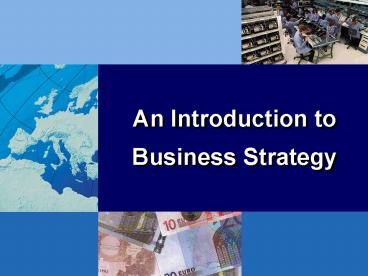An Introduction to Business Strategy - PowerPoint PPT Presentation
1 / 18
Title:
An Introduction to Business Strategy
Description:
Porter's five forces model. the bargaining power of suppliers. the bargaining power of buyers ... Porter's Five Forces Model. Source: Michael E. Porter ... – PowerPoint PPT presentation
Number of Views:562
Avg rating:3.0/5.0
Title: An Introduction to Business Strategy
1
An Introduction to Business Strategy
2
What is Strategy?
- A company's objectives and philosophy
- Defining strategy
- the five 'Ps' of strategy
- a plan
- a ploy
- a pattern of behaviour
- a position with respect to others
- a perspective
- strategy as a mix of the five Ps
3
What is Strategy?
- Strategic management
- strategic and day-to-day management
- the components of strategic management
- strategic analysis
- strategic choice
- strategic implementation
- different business types
- big or small business
- manufacturing or service provider business
- domestic or multinational business
- private-sector or public-sector business
- for-profit or not-for-profit organisations
4
Strategic Analysis
- Factors affecting strategic choices
- The business environment
- PEST analysis
- Porter's five forces model
- the bargaining power of suppliers
- the bargaining power of buyers
- the threat of potential new entrants
- the threat of substitutes
- the extent of competitive rivalry
5
Porter's Five Forces Model
Industry competitors
Source Michael E. Porter Competitive Strategy
Techniques for Analyzing Industries and
Competitors, (The Free Press, 1980)
6
Porter's Five Forces Model
Industry competitors Rivalry among existing
firms
Source Michael E. Porter Competitive Strategy
Techniques for Analyzing Industries and
Competitors, (The Free Press, 1980)
7
Porter's Five Forces Model
Potential entrants
Threat of new entrants
Industry competitors Rivalry among existing
firms
Source Michael E. Porter Competitive Strategy
Techniques for Analyzing Industries and
Competitors, (The Free Press, 1980)
8
Porter's Five Forces Model
Potential entrants
Threat of new entrants
Industry competitors Rivalry among existing
firms
Threat of substitutes
Substitute products
Source Michael E. Porter Competitive Strategy
Techniques for Analyzing Industries and
Competitors, (The Free Press, 1980)
9
Porter's Five Forces Model
Potential entrants
Threat of new entrants
Industry competitors Rivalry among existing
firms
Bargaining power of suppliers
Suppliers
Threat of substitutes
Substitute products
Source Michael E. Porter Competitive Strategy
Techniques for Analyzing Industries and
Competitors, (The Free Press, 1980)
10
Porter's Five Forces Model
Potential entrants
Threat of new entrants
Industry competitors Rivalry among existing
firms
Bargaining power of suppliers
Bargaining power of buyers
Buyers
Suppliers
Threat of substitutes
Substitute products
Source Michael E. Porter Competitive Strategy
Techniques for Analyzing Industries and
Competitors, (The Free Press, 1980)
11
Strategic Analysis
- Porter's five forces model (cont.)
- Factors affecting each of the forces
- the bargaining power of suppliers
- the bargaining power of buyers
- the threat of potential new entrants
- the threat of substitutes
- the extent of competitive rivalry
- Limitations of the five forces model
12
Strategic Analysis
- Value chain analysis
- nature of value chain analysis
- sustainable competitive advantage
- the value chain
- primary activities
- inbound logistics
- operations
- outbound logistics
- marketing and sales
- service
- secondary activities
- procurement
- technological development
- human resources management
- firm infrastructure
13
The value chain
Technological development
Human resource management
Firm infrastructure
Procurement
Inbound logistics
14
Strategic Analysis
- Vision and mission
- attitudes towards various stakeholders
- influences on a firm's vision and mission
15
Factors influencing organisational purpose
Organisational purpose
16
Strategic Choice
- Environment or market-based strategy
- types
- cost leadership
- differentiation
- focus
- importance of establishing-
- the basis of a firm's competitive advantages
- the nature of the target market
- Resource-based strategy
- exploiting core competencies
- defining and establishing core competencies
17
Business Strategy in a Global Economy
- Why go global?
- market size
- increased profitability
- location economies
- scope for significant cost reductions
- using core competencies
- learning from experience in diverse markets
- spreading risks
- keeping up with rivals
- The global strategy trade-off
- economies of scale or higher costs of
customisation? - determinants of trade-off
18
Strategy Evaluation and Implementation
- Evaluation
- importance of weighing up alternative strategies
- how feasible are they?
- how do they relate to the firm's goals?
- how will they affect the firm's competitive
position? - Implementation
- need to assess the following
- resourcing
- business culture and structure
- managing change































